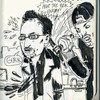Welcome to Routine Moments in Baseball History, a running weekday feature that will take a look back at plays that have been ignored by the history books because history books only talk about things that are important or interesting. Today's installment is "Ping Bodie Walks to the Plate." Lots of information here comes from this excellent biographical sketch.When Ping Bodie walked up to the plate at Cleveland's dusty Dunn Field 97 years ago, there would have been a little bit more energy suddenly running through the place. The Philadelphia Athletic would have been cradling his heavy 52-ounce bat—that's where he got his first name from, the sound the ball made when it flew off his lumber—and maybe squinting in the sun at the Indians' starting pitcher, Jim Bagby. Bodie—born Francesco Stephano, but baseball player's names went through all kinds of contortions back then—was a short, heavy fellow with a thick neck, arms too long for his body, and a shaggy grin. He didn't look like an athlete; he could have been a carpenter or an electrician, which he was, actually—he ran wires and acted in bit parts for Universal Studios after finally retiring from the game in 1928.That year, 1917, was his first season back in the majors after a stint with the minor league California Seals. He went all over the country during his long career—he also played in Chicago and Iowa and Texas and New York, where he roomed with Babe Ruth—and was a fan favorite because of his cheerfully insane antics. He once competed against an ostrich in a spaghetti eating contest—the bird lost, and reportedly died from overconsumption—and was fond of bragging about his hitting prowess using terms teetering on the edge of nonsense. He could "hemstitch the spheroid" and "whale the old apple"; when he was asked, at the age of 73, whether he could still swing a bat, he replied, "Give me the mace and I'll drive the pumpkin down Whitey Ford's throat." His biography sounds like that of a lumbering character in a novel, and he was reportedly the model for the narrator in Ring Lardner's famous book You Know Me Al, a country bumpkin adrift in the majors and the big city.He was a figure of fun, and Clevelanders might have come out to the ballpark that sleepy summer afternoon just to see what he would do. They also might have just wanted to watch him hit—he would go on to bat .291 with an OPS of .774 and seven home runs that season, which are unimpressive numbers until you realize that that was the sixth-most dingers anyone would hit in 1917. He was a big-bellied prankster swinging a giant bat, the only reason to watch the abysmal Athletics, the worst team in the American League.Nothing really happened, though, when Bodie strolled to the plate that day—or if it did, history didn't record it. Fans may have shouted things at him, he may have shouted back, flashing that smile at them, and then he would have gotten to the box and taken his stance. He'd get a couple hits and knock in a couple of runs over the course of the game, not that it would matter: The Indians beat the Athletics 20-6.This has been Routine Moments in Baseball History. Follow Harry Cheadle on Twitter.
Photo via Flickr user Curtis Cronn
